‘Killers of the Flower Moon’ Is Scorsese’s Macbeth Adaptation
Killers of the Flower Moon (2023) is, at the time of writing, sitting at a total box office gross of $138m. Against a budget of $200m, it’s likely that it will take many years of streaming rights and DVD sales to make back its money. What this says for the fate of non-franchise cinema is a topic for another day and another article, but what is of relevance is the topic of the representation of the Native Americans in the film. Depending on which article you read, the film is either praised as a much-needed spotlight on a people that have had their way of life consumed by white people, or is just three hours of watching a culture brutally attacked (this article in The Guardian does a fairly good job at covering the major points). Whether the depiction of the Osage people would have attracted as much attention for a little direct-to-DVD film instead of a nine-figure Hollywood star-led feature is also up for debate, asking questions about how the relevance of filmic presentations of people change depending on the amount of eyes and cultural prestige the texts are deemed to have.
These debates are of relevance to this article because, in reality, the identities of the two clashing cultures (that of the Osage, and the all-consuming wave of capitalist USA) are largely irrelevant to the thematic core of the story. They are relevant in that they are only tangential to the beating heart of the point of the film. This specific filmic presentation of this storyline uses the Osage and white USA as two sides of the coin, but you could transplant this to colonial Africa with Britain exploiting the native peoples of those nations and it could be the same frame with differing cosmetics. Put a French colonial power in Vietnam or Morocco, and the same is there. Go to Tasmania and look at the occupying forces there, as Jennifer Kent did with her revenge western The Nightingale. The principals remain constant, an examination of the deliberate exercise of colonial, oppressional power over the native inhabitants of a land. This is what the surface level of Killers of the Flower Moon would have us take away.
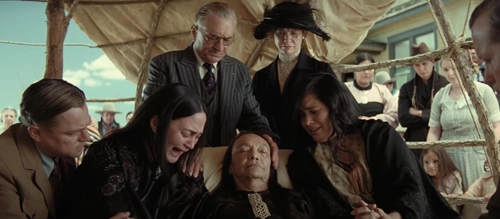
Whilst KOTFM is based on a book (“Killers of the Flower Moon: The Osage Murders and the Birth of the FBI”, by David Grann), which is in turn based on real events, it is the specific presentation of events in Martin Scorsese’s film which are of discussion here. This film’s narrative, detailing the marriages and assassinations of Osage people at the hands of white locals in order for the white people to strategically inherit their oil-rich land, is not the centre of the film. It is not what it is all about. As is often the case, the plot and the story are different levels of communication.
Instead, the film is actually about the relationship between Ernest Burkhart (Leonardo DiCaprio) and William King Hale (Robert De Niro), and the exploitation of a malleable, weak individual by a stronger, more ambitious, and more ruthless mind. The plot goes along, but what drives it is the obedience and defiance of Burkhart to his powerful uncle. De Niro is the snake whispering in DiCaprio’s Eve of an ear with the promise of power from the metaphorical tree of knowledge. It is about evil corrupting those who are on the fence, and dragging them down to the ground. Once we realise this, we see that much of KOTFM plays out as a reinterpretation of William Shakespeare’s “Macbeth”, written over 400 years ago. Not everything lines up perfectly (that’s how reinterpretations work; Akira Kurosawa had the three witches changed for a single medium in Throne of Blood, for example), but there are enough similarities to line up fairly nicely.
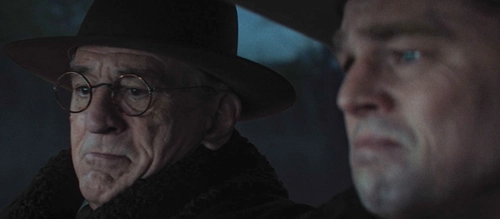
Macbeth, warlord for King Duncan of Scotland, begins the play having just taken out Macdonald, an usurper to the throne. His penchant for violence is well noted, and in killing Macdonald, ‘unseam’d him from the nave to th’chops’. In KOTFM, Earnest Burkhart may not be quite that violent, but he does return at the film’s opening from WWI, so they both have that ability in them, having both returned from national combat. In Macbeth, the titular character is told of a prophecy that he will one day be king, which he expresses with his wife. Lady Macbeth then takes charge, constantly whispering to him that the prophecy will come true, that he will be king. She already has a plan. Everything will be OK. She tells her husband ‘look like the innocent flower,/ But be the serpent udner’t.’ The mention of flowers here is obviously mere coincidence in connection with the film’s title, but it is exactly this notion of being the evil hiding in plain sight under a notion of goodness which both Ernest and King act out in KOTFM. King is constantly giving out grants and finances to the community, and is fluent in the Dhegihan Siouan language of the Osage. Lady Macbeth, in Duncan’s words, is ‘our honour’d hostess!’. The similarities are plain to see in the setup. Lady Macbeth manipulates her husband into carrying out murders so that he will become King and inherit the country, and make her queen by default, which is what she is really after. In KOTFM, Ernest is manipulated by King to carry out murders so that Ernest will inherit the wealthy land, and King will get some of the wealth as a result. Once more, the whisperer in the ear is not so much concerned with the wellbeing of their familiar, but what their understudy’s success will mean for them.
A common misconception with Macbeth’s character is that he is a tyrant and ambitious warlord right from the start. He may well have ambition, but most of his actions are as a result of the persuasion of his wife, and then being in too deep to pull out. Macbeth asks before murdering the king what happens ‘If we should fail?’, and Lady Macbeth has to reassure him to ‘nail your courage to the sticking place,/ And we’ll not fail.’ He constantly questions whether what he is doing is right, hallucinating the murderous dagger before going to kill Duncan, his mind already fracturing under the pressure. After one murder, everything runs away from him, and he has no choice but to keep going. He must kill his friend, Banquo, not only because of the witches’ prophecy that Banquo will sire a line of kings, but because of Banquo’s tendency to sit on the fence about absolutes. Banquo is unsure about the intentions of the witches, ‘oftentimes, to win us to our harm,/ The instruments of darkness tell us truths,/ Win us with honest trifles…’ and even muses to himself as part of a soliloquy to open Act 3 Scene 1, about Macbeth becoming king, that ‘Thou play’dst most foully for’t…’ It’s clear that Banquo would never be on Macbeth’s side, for as much as he is Macbeth’s friend and similar in many ways (he is also a great warrior on the battlefield, and fought alongside Macbeth against Macdowell), he is always on the side of justice and so must be silenced. Macbeth therefore pays two assassins to take out Banquo to keep himself in power. After this, when Macduff flees, Macbeth brands him a traitor and must kill his family as a warning against uprising. He rules with the sheer intention of holding onto the power he was (to an extent) pressured into. With his wife’s persuasion, he has dug a hole, and he refuses to stop digging, instead continuing down in the hopes of an escape.
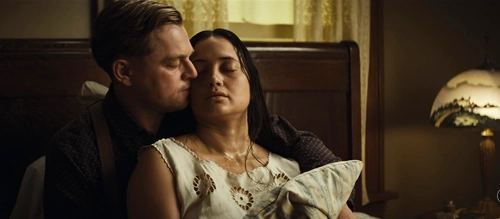
Ernest likewise finds himself executing more and more murders in order to maintain his position and keep himself close to King. He pays to have Harry Roan killed as part of King’s plan, but it goes wrong, showing that Ernest isn’t as completely in control of things as he would like to think. He later hires for the murder of more family members, which begins to put his wife Molly into a kind of surrogate role for three characters; that of Duncan (the one who holds the power), Banquo (someone he must kill, and appears, ghostlike, to haunt and prevent Ernest from keeping himself completely on the dark side), and eventually Macduff (when she goes to Washington to bring reinforcements to out the tyrant). Note that like Macbeth, Ernest is often reticent to kill himself, and on multiple occasions gets others to carry out his dirty work for him.
It is, tangentially, interesting that a deliberate highlighting of King’s membership to freemasonry is made in the outcome of the botched assassination of Roan, as this implies a belief in a supreme being. There are a lot of supernatural moments in Macbeth, from witches to prophecies to apparitions to ghosts, to the appearance of Hecate (for almost no reason except to tell the witches to go somewhere and have a musical number; got to maintain audience interest somehow). But Lady Macbeth also clearly believes in spirits, through her belief that the prophecy must come true, and explicitly in her speech calling to them; ‘Come, you spirits/ That tend on mortal thoughts…’ Once again, more parallels appear.
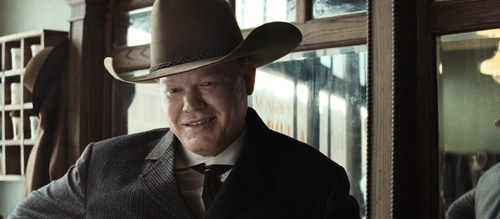
In the second half of Killers of the Flower Moon, the new Bureau of Investigation is brought into the scene by Molly, Ernest’s wife, fulfilling her role as a partial avatar for Macduff. Led by Jesse Plemons’ Tom White (who plays the military side of Macduff), a kind of army from a land far away (Washington standing in for England, in a twist of irony for American history), arrives in the town. The BOI is not exactly the moving copse of Burnham’s wood, but what is interesting is not necessarily the arrival of the cavalry, but what this does for Ernest, who the plot centres around.
In the final reels he undergoes a constant turmoil of emotions. This mix has been seen throughout in relation to his seemingly genuine affection for his wife, Molly, and at one point he swallows some of the poison he has been putting in her insulin. The similarity to Macbeth Act 3 Scene 2, where Macbeth is tormented by what he is doing, beautifully demonstrated by the famous line of ‘full of scorpions is my mind, dear wife!’, is interesting, as scorpions are known for their poisonous sting.
Three points are of note in the finale of the film and play in relation to this turmoil. Firstly, Ernest is initially convinced to fight on and defend King by the townsfolk (the white ones, at least), in order to preserve their way of life; after all, King is a great benefactor for the town. In Macbeth, despite the army marching toward them and the apparent tyrannical rule of Macbeth (Macduff describes him as the ‘fiend of Scotland’), he still has servants and doctors attending him, messengers, and so on. However, overcome by sorrow for his child who has passed away, Ernest decides to testify against King. This idea that the battle is perhaps lost is mirrored in Macbeth’s final soliloquy, where he stares into the abyss of time and finds life meaningless, the fighting pointless, the murder empty. Life, he says, ‘is a tale/ Told by an idiot, full of sound and fury,/ Signifying nothing.’ However, there is still a little of that bitterness in him. Macbeth still fights on, despite Macduff telling him that the prophecy has come true and Macbeth can die by his hand. He says, ‘I throw my warlike shield: lay on, Macduff;/ And damn’d be him that first cries ‘Hold, enough!’ Similarly, Ernest can’t admit to Molly, when she has recovered and she knows he was poisoning her, even with prison just around the corner, that he was putting the poison in the insulin. Like Macbeth, there’s still that initial grain of darkness left inside him. It’s not a big, eye-popping finale as seen in Justin Kurzel’s direct 2015 adaptation, but it is a moving finale nonetheless.
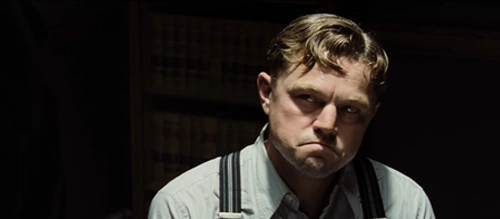
This article hasn’t been to say that Scorsese deliberately set out to make a new version of a classic Shakespeare tale with this film. It’s not even to say that Scorsese must have been deliberately conscious of Macbeth when adapting the script. Indeed, most of the elements (though shifted and changed a little for dramatic purposes), were based on the real serial murders of innocent people – the real Ernest Burkhart and William King Hale were despicable individuals. For all of the extraordinary influence of The Bard, he didn’t create these people. Additionally, by saying that this presentation of the narrative echoes Macbeth should not in any way be taken as a suggestion that it reduces these figures to caricatures. Real lives were lost needlessly and cruelly by individuals hellbent on murder for their own material gain.
What it does hope to show, however, is how much William Shakespeare was able to put a finger on human nature, and how he was seemingly able to immortalise it in a narrative that has its unconscious echoes throughout time, to be rediscovered in the most unlikely of places. The real history and folklore that inspired Shakespeare to write Macbeth were not invented by him, but he found a way to use it to shine a light on the folly of humankind, and the corruption underneath polite society. That these narrative ideas find their way across the centuries, across the waters, to Scorsese’s film (which did have script changes in development, showing that differing perspectives and angles even to real events are possible), proves if nothing else that cinema as a medium has harsh truths inside its beams of light. That these stories are still relevant, redigested, disguised, and re-presented, is both a damning proof of humanity’s inability to learn from its past, and a testament to storytelling’s continued effort to plead with us to listen.
Recommended for you: Killers of the Flower Moon (2023) Review

